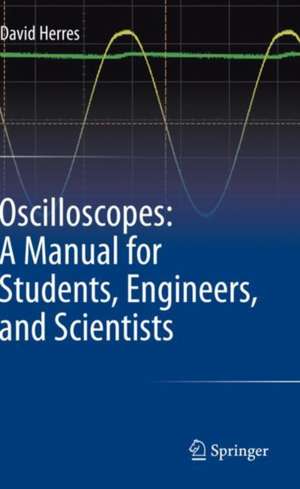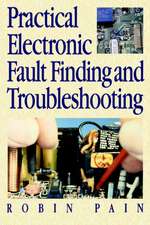Oscilloscopes: A Manual for Students, Engineers, and Scientists
Autor David Herresen Limba Engleză Paperback – 8 oct 2021
| Toate formatele și edițiile | Preț | Express |
|---|---|---|
| Paperback (1) | 261.73 lei 38-44 zile | |
| Springer International Publishing – 8 oct 2021 | 261.73 lei 38-44 zile | |
| Hardback (1) | 263.04 lei 38-44 zile | |
| Springer International Publishing – 7 oct 2020 | 263.04 lei 38-44 zile |
Preț: 261.73 lei
Nou
Puncte Express: 393
Preț estimativ în valută:
50.09€ • 51.97$ • 41.86£
50.09€ • 51.97$ • 41.86£
Carte tipărită la comandă
Livrare economică 11-17 martie
Preluare comenzi: 021 569.72.76
Specificații
ISBN-13: 9783030538873
ISBN-10: 3030538877
Pagini: 267
Ilustrații: X, 267 p. 192 illus., 168 illus. in color.
Dimensiuni: 155 x 235 x 18 mm
Greutate: 0.48 kg
Ediția:1st ed. 2020
Editura: Springer International Publishing
Colecția Springer
Locul publicării:Cham, Switzerland
ISBN-10: 3030538877
Pagini: 267
Ilustrații: X, 267 p. 192 illus., 168 illus. in color.
Dimensiuni: 155 x 235 x 18 mm
Greutate: 0.48 kg
Ediția:1st ed. 2020
Editura: Springer International Publishing
Colecția Springer
Locul publicării:Cham, Switzerland
Cuprins
Introduction.- History of Oscilloscopes/ Fourier’s mathematical transformation.- Semiconductors inside the oscilloscope and as objects of inquiry.- Bench-top vs. hand-held, battery-operated instruments, and use of the differential probe.- The math function in oscilloscopes.- Oscilloscope memory depth and sampling rate problems.- Using cursors to measure the value of a function.- Oscilloscope troubleshooting techniques.- Networking oscilloscopes with each other and with local and remote computers.- The PC-based oscilloscopes.- Triggered-sweep digital storage oscilloscope block diagram.- What lies ahead – In a nutshell, Artificial Intelligence
Notă biografică
David Herres is a Contributing Editor of DesignWorld/Test & Measurement and has been writing electrical work and electronics in professional journals since 2006 and is the author of four books on National Electrical Code and Electronics.
Textul de pe ultima copertă
This text presents readers with an engaging while rigorous manual on the use of oscilloscopes in laboratory and field settings. It describes procedures for measuring and displaying waveforms, gives examples of how this information can be used for repairing malfunctioning equipment and developing new designs, and explains steps for debugging pre-production prototypes. The book begins by examining how the oscilloscope displays electrical energy as traces on X and Y co-ordinates, freely transitioning without loss of information between time and frequency domains, in accordance with the Fourier Transform and its modern correlate, the Fast Fourier Transform. The book continues with practical applications and case studies, describes how oscilloscopes are used in diagnosing pulse width modulation (PWM) problems--looking at serial data streaming and analyzing power supply noise and premises power quality issues—and emphasizes the great functionality of mixed-signal as opposed to mixed-domain oscilloscope, and earlier instruments. Featuring many descriptions of applications in applied science and physics, Oscilloscopes: A Manual for Students, Engineers, and Scientists is ideal for students, faculty, and practitioners.
Caracteristici
Introduces physical basis and characteristics of electrical and naturally occurring waves and how wave energy at the oscilloscope input becomes waveforms on the display Explains use of oscilloscopes in many applications in engineering and physics Reinforces concepts covered with case examples and end of chapter questions and solutions Describes the instrument’s circuitry, methods for digitizing analog signals, signal processing and display, debugging prototypes, and troubleshooting faulty equipment Includes the oscilloscope’s history, evolution, and recent development

